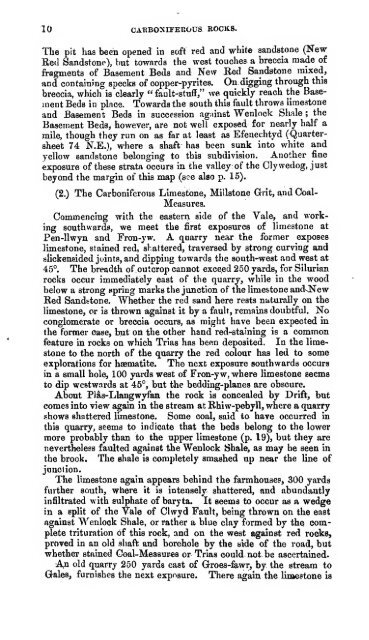The geology of the neighbourhoods of Flint, Mold, and Ruthin ...
The geology of the neighbourhoods of Flint, Mold, and Ruthin ...
The geology of the neighbourhoods of Flint, Mold, and Ruthin ...
Create successful ePaper yourself
Turn your PDF publications into a flip-book with our unique Google optimized e-Paper software.
10 CAHBOXIFETCOUS BOCKS.<br />
<strong>The</strong> pit has been opened in s<strong>of</strong>t red <strong>and</strong> white s<strong>and</strong>stone (New<br />
Red S<strong>and</strong>stone), but towards <strong>the</strong> west touches a breccia made o£<br />
fragments <strong>of</strong> Basement Beds <strong>and</strong> New Red S<strong>and</strong>stone mixed,<br />
<strong>and</strong> containing specks <strong>of</strong> copper-pyrites. On. digging through this<br />
breccia, which is clearly " fault-stuff," we quickly reach <strong>the</strong> Basement<br />
Beds in place. Towards <strong>the</strong> south this fault throws limestone<br />
<strong>and</strong> Basement Beds in succession against Wenlock Shale ; <strong>the</strong><br />
Basement Beds, however, are not well exposed for nearly half a<br />
mile, though <strong>the</strong>y run on as far at least as Efenechtyd (Quartersheet<br />
74 N.E.), where a shaft has been sunk into white <strong>and</strong><br />
yellow s<strong>and</strong>stone belonging to this subdivision. Ano<strong>the</strong>r fine<br />
exposure <strong>of</strong> <strong>the</strong>se strata occurs in <strong>the</strong> valley: <strong>of</strong> <strong>the</strong> Clywedog, just<br />
beyond <strong>the</strong> margin <strong>of</strong> this map (see also p. 15).<br />
(2.) <strong>The</strong> Carboniferous Limestone, Millstone Grit, <strong>and</strong> Coal-<br />
Measures.<br />
Commencing with <strong>the</strong> eastern side pf <strong>the</strong> Vale, <strong>and</strong> working<br />
southwards, we meet <strong>the</strong> first exposures <strong>of</strong> limestone at<br />
Pen-llwyn <strong>and</strong> Fron-yw. A quarry near <strong>the</strong> former exposes<br />
limestone, stained red, shattered, traversed by strong curving <strong>and</strong><br />
slickensided joints, <strong>and</strong> dipping towards <strong>the</strong> south-west <strong>and</strong> west at<br />
45°. <strong>The</strong> breadth <strong>of</strong> outcrop cannot exceed 250 yards, for Silurian<br />
rocks occur immediately east <strong>of</strong> <strong>the</strong> quarry, while in <strong>the</strong> wood<br />
below a strong ppring marks <strong>the</strong> junction <strong>of</strong> <strong>the</strong> limestone <strong>and</strong>sNew<br />
Red S<strong>and</strong>stone. Whe<strong>the</strong>r <strong>the</strong> red s<strong>and</strong> here rests naturally on <strong>the</strong><br />
limestone, or is thrown against it by a fault, remains doubtful. No<br />
conglomerate or breccia occurs, as might have been expected in<br />
<strong>the</strong> former case, but on <strong>the</strong> o<strong>the</strong>r h<strong>and</strong> red^-staining is a common<br />
feature in rocks on which Trias has been deposited. In <strong>the</strong> limestone<br />
to <strong>the</strong> north <strong>of</strong> <strong>the</strong> quarry <strong>the</strong> red colour has led to some<br />
explorations for haematite. <strong>The</strong> next exposure southwards occurs<br />
in a small hole, 100 yards west <strong>of</strong> Fron-yw, where limestone seems<br />
to dip westwards at 45°, but <strong>the</strong> bedding-planes are obscure.<br />
About Plas-Llangwyfam <strong>the</strong> rock is concealed by Drift, but<br />
comes into view again in <strong>the</strong> stream at Rhiw-pebyll, where a quarry<br />
shows shattered limestone. Some coal, said to have occurred in<br />
this quarry, seems to indicate that <strong>the</strong> beds belong to <strong>the</strong> lower<br />
more probably than to <strong>the</strong> upper limestone (p. 19), but <strong>the</strong>y are<br />
never<strong>the</strong>less faulted against <strong>the</strong> Wenlock Shale, as may be seen in<br />
<strong>the</strong> brook. <strong>The</strong> shale is completely smashed up near <strong>the</strong> line <strong>of</strong><br />
junction.<br />
<strong>The</strong> limestone again appears behind <strong>the</strong> farmhouses, 300 yards<br />
fur<strong>the</strong>r south, where it is intensely shattered, <strong>and</strong> abundantly<br />
infiltrated with sulphate <strong>of</strong> baryta. It seems to occur as a wedge<br />
in a split <strong>of</strong> <strong>the</strong> Vale <strong>of</strong> Clwyd Fault, being thrown on <strong>the</strong> east<br />
against Wenlock Shale, or ra<strong>the</strong>r a blue clay formed by <strong>the</strong> complete<br />
trituration <strong>of</strong> this rock, <strong>and</strong> on <strong>the</strong> west against red rocks,<br />
proved in an old shaft <strong>and</strong> borehole by <strong>the</strong> side <strong>of</strong> <strong>the</strong> road, but<br />
•whe<strong>the</strong>r stained Goal-Measures or Trias could not be ascertained.<br />
An old quarry 250 yards east <strong>of</strong> Groes-fawr, by <strong>the</strong> stream to<br />
Gales, furnishes <strong>the</strong> next exposure. <strong>The</strong>re again <strong>the</strong> limestone is



